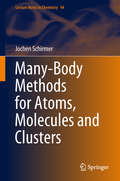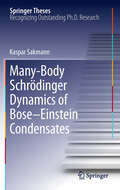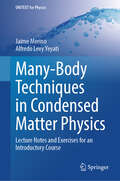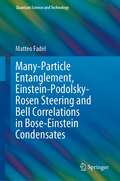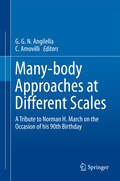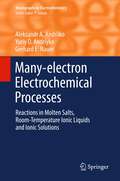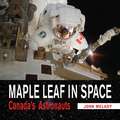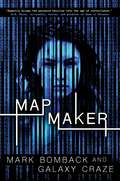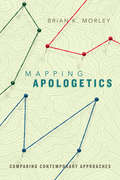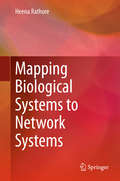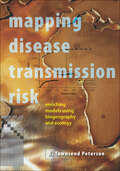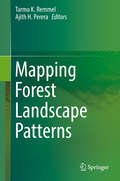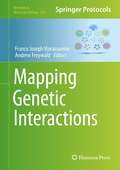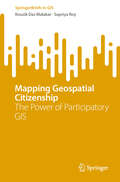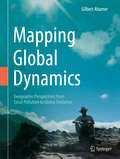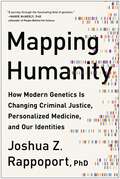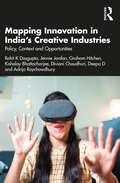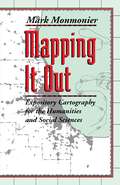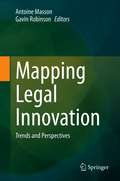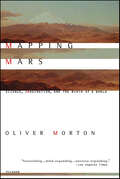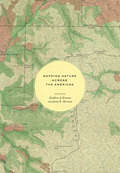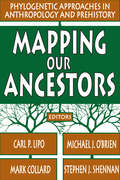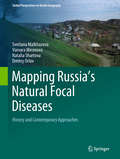- Table View
- List View
Many-Body Methods for Atoms, Molecules and Clusters (Lecture Notes In Chemistry Ser. #94)
by Jochen SchirmerThis book provides an introduction to many-body methods for applications in quantum chemistry. These methods, originating in field-theory, offer an alternative to conventional quantum-chemical approaches to the treatment of the many-electron problem in molecules. Starting with a general introduction to the atomic and molecular many-electron problem, the book then develops a stringent formalism of field-theoretical many-body theory, culminating in the diagrammatic perturbation expansions of many-body Green's functions or propagators in terms of Feynman diagrams. It also introduces and analyzes practical computational methods, such as the field-tested algebraic-diagrammatic construction (ADC) schemes. The ADC concept can also be established via a wave-function based procedure, referred to as intermediate state representation (ISR), which bridges the gap between propagator and wave-function formulations. Based on the current rapid increase in computer power and the development of efficient computational methods, quantum chemistry has emerged as a potent theoretical tool for treating ever-larger molecules and problems of chemical and physical interest. Offering an introduction to many-body methods, this book appeals to advanced students interested in an alternative approach to the many-electron problem in molecules, and is suitable for any courses dealing with computational methods in quantum chemistry.
Many-Body Schrödinger Dynamics of Bose-Einstein Condensates
by Kaspar SakmannAt extremely low temperatures, clouds of bosonic atoms form what is known as a Bose-Einstein condensate. Recently, it has become clear that many different types of condensates -- so called fragmented condensates -- exist. In order to tell whether fragmentation occurs or not, it is necessary to solve the full many-body Schrödinger equation, a task that remained elusive for experimentally relevant conditions for many years. In this thesis the first numerically exact solutions of the time-dependent many-body Schrödinger equation for a bosonic Josephson junction are provided and compared to the approximate Gross-Pitaevskii and Bose-Hubbard theories. It is thereby shown that the dynamics of Bose-Einstein condensates is far more intricate than one would anticipate based on these approximations. A special conceptual innovation in this thesis are optimal lattice models. It is shown how all quantum lattice models of condensed matter physics that are based on Wannier functions, e.g. the Bose/Fermi Hubbard model, can be optimized variationally. This leads to exciting new physics.
Many-Body Techniques in Condensed Matter Physics: Lecture Notes and Exercises for an Introductory Course (UNITEXT for Physics)
by Jaime Merino Alfredo Levy YeyatiThis book presents the lecture notes and exercises corresponding to the course "Quantum Field Theoretical Methods in Condensed Matter" that the authors imparted for several years as part of the masters program on Condensed Matter and Biological Systems at the Autonoma University of Madrid. It provides a step-by-step description of the material which will benefit not only professors wishing to undertake a similar task, but also interested students. Additionally, the book provides a complete set of exercises on the various topics along with hints about how to solve them, a feature frequently absent in textbooks on many-body techniques. As well as addressing the traditional topics in the field (diagrammatic techniques, screening in metals, Fermi liquid theory, electron-phonon interactions, etc.) the text also covers less conventional topics such as the application of non-equilibrium Green function techniques to quantum transport in normal and superconducting nanoscale devices.
Many-Body Theory of Condensed Matter Systems: An Introductory Course
by Michael G. Cottam Zahra HaghshenasfardIn this primer to the many-body theory of condensed-matter systems, the authors introduce the subject to the non-specialist in a broad, concise, and up-to-date manner. A wide range of topics are covered including the second quantization of operators, coherent states, quantum-mechanical Green's functions, linear response theory, and Feynman diagrammatic perturbation theory. Material is also incorporated from quantum optics, low-dimensional systems such as graphene, and localized excitations in systems with boundaries as in nanoscale materials. Over 100 problems are included at the end of chapters, which are used both to consolidate concepts and to introduce new material. This book is suitable as a teaching tool for graduate courses and is ideal for non-specialist students and researchers working in physics, materials science, chemistry, or applied mathematics who want to use the tools of many-body theory.
Many-Particle Entanglement, Einstein-Podolsky-Rosen Steering and Bell Correlations in Bose-Einstein Condensates (Quantum Science and Technology)
by Matteo FadelThis book presents theoretical methods and experimental results on the study of multipartite quantum correlations in spin-squeezed Bose–Einstein condensates. Nonclassical correlations in many-body systems are particularly interesting for both fundamental research and practical applications. For their investigation, ultracold atomic ensembles offer an ideal platform, due to their high controllability and long coherence times. In particular, we introduce criteria for detecting and characterizing multipartite entanglement, Einstein–Podolsky–Rosen steering, and Bell correlations. Moreover, we present the experimental observation of such correlations in systems of about 600 atoms.
Many-body Approaches at Different Scales: A Tribute To N. H. March On The Occasion Of His 90th Birthday
by G.G.N Angilella C. AmovilliThis book presents a collection of invited research and review contributions on recent advances in (mainly) theoretical condensed matter physics, theoretical chemistry, and theoretical physics. The volume celebrates the 90th birthday of N.H. March (Emeritus Professor, Oxford University, UK), a prominent figure in all of these fields. Given the broad range of interests in the research activity of Professor March, who collaborated with a number of eminent scientists in physics and chemistry, the volume embraces quite diverse topics in physics and chemistry, at various dimensions and energy scales. One thread connecting all these topics is correlation in aggregated states of matter, ranging from nuclear physics to molecules, clusters, disordered condensed phases such as the liquid state, and solid state physics, and the various phase transitions, both structural and electronic, occurring therein. A final chapter leaps to an even larger scale of matter aggregation, namely the universe and gravitation. A further no less important common thread is methodological, with the application of theoretical physics and chemistry, particularly density functional theory and statistical field theory, to both nuclear and condensed matter.
Many-electron Electrochemical Processes
by Yuriy O Andriyko Gerhard E. Nauer Aleksandr A. AndriikoHere, the authors provide a unified concept for understanding multi-electron processes in electrochemical systems such as molten salts, ionic liquids, or ionic solutions. A major advantage of this concept is its independence of assumptions like one-step many-electron transfers or 'discrete' discharge of complex species. Therefore this monograph is a unique resource for basic electrochemical research but also for many important applications such as electrodeposition, electrorefining, or electrowinning of polyvalent metals from molten salts and other ionic media.
Maple Leaf in Space: Canada's Astronauts
by John MeladyMarc Garneau, Roberta Bondar, Julie Payette, Robert Thirsk, Chris Hadfield, and more recently, Guy Laliberté, the founder of Cirque de Soleil, all have one thing in common: they’re some of the very few Canadians who have been in space. The launch of a spaceship is terribly exciting. That’s why thousands of people come to watch. They laugh, cheer, and applaud as the rocket rises. They see the smoke, steam, and white-hot fire as millions of litres of fuel burn in seconds. They feel the chest-thumping impact of the sound. Then they stare upward for a long time until they can no longer see even a tiny speck in the distant sky. By that time, the craft is in space. Canada’s astronauts come from across the nation: from farms, cities, and little towns. They went to large schools and to small ones. Maple Leaf in Space showcases these amazing Canadians who have ventured off our planet and delivers some of the thrill of what that’s like.
Mapmaker
by Galaxy Craze Mark Bomback"Mapmaker expertly brings the paranoid thriller into the age of surveillance, and the result is both moving and chilling."--D.B. Weiss, co-creator, writer, and producer of Game of ThronesWhen Tanya Barrett takes an internship at MapOut, she expects emotional landmines. Her father cofounded the digital mapping company, and he died for it--on a cartographic expedition he didn't even need to take. Her father's business partner and his son, Connor, welcome her to the job with open arms. And being with Connor, an old childhood friend, turns out to be the only thing that makes Tanya feel normal again. Soon she's spending every moment she can with Connor. But when they sneak into her father's old office late one night, they stumble across a deadly secret. The next day Connor disappears.Tanya isn't just bereft; she's terrified. It's clear that people at MapOut are willing to kill for what she and Connor discovered. Alone again--and on the run--Tanya must rely on her wits to find out what happened to him and stay a step ahead of MapOut. But in the world they envision, no one stays lost for long.
Mapping Apologetics: Comparing Contemporary Approaches
by Brian K. MorleyEveryone believes something. But how and why do people believe? What counts as evidence? How much can be assumed or believed by faith alone? When it comes to religious faith, the questions become at once more difficult and more important. Over the centuries, Christians have offered different approaches to explaining or defending the Christian faith, a discipline known as apologetics. But it has not always been clear how different apologetic methods work, or what each approach has to offer. In this comprehensive survey, Brian Morley provides an overview of Christian apologetic approaches and how they differ. He explores the historical and philosophical underpinnings of key figures and major schools of thought, from the presuppositionalism of Cornelius Van Til to the evidentialism of Gary Habermas. Moving beyond theory, Morley also covers apologetic application, demonstrating how each view works out in practical terms. This guide covers the complexities of apologetics in a way that is accessible to the nonspecialist. Even-handed and respectful of each apologist and their contribution, this book provides the reader with a formidable array of defenses for the faith.
Mapping Biological Systems to Network Systems
by Heena RathoreThebook presents the challenges inherent in the paradigm shift of network systemsfrom static to highly dynamic distributed systems - it proposes solutions thatthe symbiotic nature of biological systems can provide into altering networkingsystems to adapt to these changes. The author discuss how biological systems -which have the inherent capabilities of evolving, self-organizing,self-repairing and flourishing with time - are inspiring researchers to takeopportunities from the biology domain and map them with the problems faced innetwork domain. The book revolves around the central idea of bio-inspiredsystems -- it begins by exploring why biology and computer network research aresuch a natural match. This is followed by presenting a broad overview ofbiologically inspired research in network systems -- it is classified by thebiological field that inspired each topic and by the area of networking inwhich that topic lies. Each case elucidates how biological concepts havebeen most successfully applied in various domains. Nevertheless, it alsopresents a case study discussing the security aspects of wireless sensornetworks and how biological solution stand out in comparison to optimizedsolutions. Furthermore, it also discusses novel biological solutions forsolving problems in diverse engineering domains such as mechanical, electrical,civil, aerospace, energy and agriculture. The readers will not only get properunderstanding of the bio inspired systems but also better insight fordeveloping novel bio inspired solutions.
Mapping Disease Transmission Risk: Enriching Models Using Biogeography and Ecology
by A. Townsend PetersonA revolutionary book that presents analytical tools for understanding why a particular disease is transmitted within a specific geographic area.A. Townsend Peterson, one of the pioneers of ecological niche modeling, presents a synthesis that illuminates new and more effective infectious disease mapping methods. His work—the culmination of twelve years of refinement—breaks new ground by integrating biogeographic and ecological factors with spatial models. Aimed at seasoned epidemiologists and public health experts, this interdisciplinary book explains the conceptual and technical underpinnings of Peterson’s approach while simultaneously describing the potentially enormous benefits of his modeling method.Peterson treats disease transmission areas for what they are—distributions of species. The book argues that complex, fragmented, and highly irregular disease patterns can only be understood when underlying environmental drivers are considered. The result is an elegant modeling approach that challenges static spatial models and provides a framework for recasting disease mapping. Anyone working in the area of disease transmission, particularly those employing predictive maps, will find Peterson’s book both inspiring and indispensable.
Mapping Forest Landscape Patterns
by Ajith H. Perera Tarmo K. RemmelThis book explores the concepts, premises, advancements, and challenges in quantifying natural forest landscape patterns through mapping techniques. After several decades of development and use, these tools can now be examined for their foundations, intentions, scope, advancements, and limitations. When applied to natural forest landscapes, mapping techniques must address concepts such as stochasticity, heterogeneity, scale dependence, non-Euclidean geometry, continuity, non-linearity, and parsimony, as well as be explicit about the intended degree of abstraction and assumptions. These studies focus on quantifying natural (i.e., non-human engineered) forest landscape patterns, because those patterns are not planned, are relatively complex, and pose the greatest challenges in cartography, and landscape representation for further interpretation and analysis.
Mapping Genetic Interactions (Methods in Molecular Biology #2381)
by Franco Joseph Vizeacoumar Andrew FreywaldThis volume details methods of identifying synthetic lethal, genetic interactions by various approaches in different model systems including human cancer cells. Chapters guide readers through genetic interactions in model organisms, RNA interference, CRISPR/Cas9 based genome editing technologies, drug-gene interactions, mapping chemical genetic interactions, synergistic drug-gene relations, single cell sequencing, gene expression profiling, and novel genetic interactions. Written in the format of the highly successful Methods in Molecular Biology series, each chapter includes an introduction to the topic, lists necessary materials and reagents, includes tips on troubleshooting and known pitfalls, and step-by-step, readily reproducible protocols. Authoritative and cutting-edge, Genetic Interaction Mapping aims to be a useful practical guide to researches to help further their study in this field.
Mapping Geospatial Citizenship: The Power of Participatory GIS (SpringerBriefs in GIS)
by Kousik Das Malakar Supriya RoyParticipatory GIS (PGIS) is important in social science research because it provides a powerful tool for exploring and comprehending various socio-spatial phenomena. It makes it easier to investigate intricate spatial relationships, community dynamics, and the effects of policies and interventions on local populations. Researchers can also use it to map and analyze the spatial distribution of social concerns, resources, and assets within a community. This Brief delves into the transformative potential of Participatory GIS (PGIS) in empowering communities and amplifying their voices through geospatial technologies. This book provides an in-depth discussion of PGIS, including approaches, data collection techniques, participatory mapping, critical discussions, the concept and thinking of geospatial citizenship, applications of participatory GIS in terms of socio-ecological concern, geographies and socio-spatial ecologies of a societal space, community cartography, challenges, and future directions. The book also offers real-world case studies that leverage PGIS technology to map the voices of ordinary people. Case studies include mapping natural resource management, modelling mangrove forest ecologies, indigenous technical knowledge of fish catching, social vulnerability to climate change in the coastal community, and identification of traditional coastal fishing sites. The book emphasizes the necessity of community involvement in decision-making processes, as well as the awareness of their perspectives in formulating policies and programs, through the lens of PGIS. It highlights how geospatial technologies can be a strong tool for community empowerment, allowing individuals to actively shape their surroundings and build a sense of ownership over their shared spaces.
Mapping Global Dynamics: Geographic Perspectives from Local Pollution to Global Evolution
by Gilbert AhamerThis book asks: What are the most suitable “mapping strategies” for detecting patterns of global dynamics?It adopts a spatial perspective when trying to understand “Global Dynamics” – and sets out to revolutionise the concept of space as such. Spatial views – on levels of increasing abstraction, reflection and self-organisation – are developed along eight case studies including air emissions, environmental radioactivity, deforestation, energy from biomass, land use change, food supply, water quality and cooperative interdisciplinary learning for global change.This book’s conceptual innovation consists in performing a transformation from “space & time” into “functional state space & evolutionary time” in order to better recognise the structural patterns of long-term global dynamics. A transdisciplinary readership in academia – including geography, philosophy, economics, global change and future research – that is interested in enlarging scientific concepts beyond classical borders – would be most welcome!
Mapping Humanity: How Modern Genetics Is Changing Criminal Justice, Personalized Medicine, and Our Identities
by Joshua Z. Rappoport"A good companion for those with a science background interested in learning more about human genetics." —Booklist Thanks to the popularity of personal genetic testing services, it's now easier than ever to get information about our own unique DNA—but who does this information really benefit? And, as genome editing and gene therapy transform the healthcare landscape, what do we gain—and what might we give up in return? Inside each of your cells is the nucleus, a small structure that contains all of the genetic information encoded by the DNA inside, your genome. Not long ago, the first human genome was sequenced at a cost of nearly $3 billion; now, this same test can be done for about $1,000. This new accessibility of genome sequence information creates huge potential for advances in how we understand and treat disease, among other things. It also raises significant concerns regarding ethics and personal privacy. In Mapping Humanity: How Modern Genetics Is Changing Criminal Justice, Personalized Medicine, and Our Identities, cellular biology expert Joshua Z. Rappoport provides a detailed look at how the explosion in genetic information as a result of cutting-edge technologies is changing our lives and our world. Inside, discover: An in-depth look at how your personal genome creates the unique individual that you are How doctors are using DNA sequencing to identify the underlying genetic causes of disease Why the field of gene therapy offers amazing potential for medical breakthroughs—and why it's taking so long The fantastic potential—and troubling concerns—surrounding genome editing The real impact—and validity—of popular personal genetic testing products, such as 23andMe Details of how molecular biology and DNA are changing the criminal justice system Facts you should know about Genetically Modified Organisms (GMOs) Throughout, in compelling, accessible prose, Rappoport explores the societal, ethical, and economic impacts of this new era. Offering a framework for balancing the potential risks and benefits of genetic information technologies and genetic engineering, Mapping Humanity is an indispensable guide to navigating the possibilities and perils of our gene-centric future.
Mapping Innovation in India’s Creative Industries: Policy, Context and Opportunities
by Kishalay Bhattacharjee Jennie Jordan Rohit K Dasgupta Graham Hitchen Diviani Chaudhuri Deepa D Adrija RoychowdhuryThe first in-depth study of the Indian creative industries, this book provides a comprehensive mapping of the Indian creative industries and its policy landscape, developing and defining key concepts and terms and offering detailed case studies of specific sectors, geographic regions and governance structures. Using an ecosystem framework, this book focuses on strategy/policy; tangible and intangible infrastructure; and funding and investment to understand the main drivers and barriers across nine sub-sector value chains. With investment from global brands into many sectors, it tracks how Indian creative industries are fostering innovation and design for social and ecological sustainability. It also delves into India’s informal economy to share key policy insights. The volume will be of great interest to scholars and researchers of public policy, business studies and South Asian studies. It will also be a key document for foreign investors willing to invest in one of the fastest-growing and stable economies in the world.
Mapping It Out: Expository Cartography for the Humanities and Social Sciences (Chicago Guides To Writing, Editing, And Publishing Ser.)
by Mark MonmonierWriters know only too well how long it can take—and how awkward it can be—to describe spatial relationships with words alone. And while a map might not always be worth a thousand words, a good one can help writers communicate an argument or explanation clearly, succinctly, and effectively. In his acclaimed How to Lie with Maps, Mark Monmonier showed how maps can distort facts. In Mapping it Out: Expository Cartography for the Humanities and Social Sciences, he shows authors and scholars how they can use expository cartography—the visual, two-dimensional organization of information—to heighten the impact of their books and articles. This concise, practical book is an introduction to the fundamental principles of graphic logic and design, from the basics of scale to the complex mapping of movement or change. Monmonier helps writers and researchers decide when maps are most useful and what formats work best in a wide range of subject areas, from literary criticism to sociology. He demonstrates, for example, various techniques for representing changes and patterns; different typefaces and how they can either clarify or confuse information; and the effectiveness of less traditional map forms, such as visibility base maps, frame-rectangle symbols, and complementary scatterplot designs for conveying complex spatial relationships. There is also a wealth of practical information on map compilation, cartobibliographies, copyright and permissions, facsimile reproduction, and the evaluation of source materials. Appendixes discuss the benefits and limitations of electronic graphics and pen-and-ink drafting, and how to work with a cartographic illustrator. Clearly written, and filled with real-world examples, Mapping it Out demystifies mapmaking for anyone writing in the humanities and social sciences. "A useful guide to a subject most people probably take too much for granted. It shows how map makers translate abstract data into eye-catching cartograms, as they are called. It combats cartographic illiteracy. It fights cartophobia. It may even teach you to find your way."—Christopher Lehmann-Haupt, The New York Times
Mapping Legal Innovation: Trends and Perspectives
by Antoine Masson Gavin RobinsonThe legal sector is being hit by profound economic and technological changes (digitalization, open data, blockchain, artificial intelligence ...) forcing law firms and legal departments to become ever more creative in order to demonstrate their added value. To help lawyers meet this challenge, this book draws on the perspectives of lawyers and creative specialists to analyze the concept and life cycle of legal innovations, techniques and services, whether related to legislation, legal engineering, legal services, or legal strategies, as well as the role of law as a source of creativity and interdisciplinary collaboration.
Mapping Mars: Science, Imagination, and the Birth of a World
by Oliver MortonWho are the extraordinary individuals that will take us on the next great space race, the next great human endeavor, our exploration and colonization of the planet Mars? And more importantly, how are they doing it? Acclaimed science writer Oliver Morton explores the peculiar and fascinating world of the new generation of explorers: geologists, scientists, astrophysicists and dreamers. Morton shows us the complex and beguiling role that mapping will play in our understanding of the red planet, and more deeply, what it means for humans to envision such heroic landscapes. Charting a path from the 19th century visionaries to the spy-satellite pioneers to the science fiction writers and the arctic explorers -- till now, to the people are taking us there -- Morton unveils the central place that Mars has occupied in the human imagination, and what it will mean to realize these dreams. A pioneering work of journalism and drama, Mapping Mars gives us our first exciting glimpses of the world to come and the curious, bizarre, and amazing people who will take us there.
Mapping Nature across the Americas
by James R. Akerman Kathleen A. BrosnanMaps are inherently unnatural. Projecting three-dimensional realities onto two-dimensional surfaces, they are abstractions that capture someone’s idea of what matters within a particular place; they require selections and omissions. These very characteristics, however, give maps their importance for understanding how humans have interacted with the natural world, and give historical maps, especially, the power to provide rich insights into the relationship between humans and nature over time. That is just what is achieved in Mapping Nature across the Americas. Illustrated throughout, the essays in this book argue for greater analysis of historical maps in the field of environmental history, and for greater attention within the field of the history of cartography to the cultural constructions of nature contained within maps. This volume thus provides the first in-depth and interdisciplinary investigation of the relationship between maps and environmental knowledge in the Americas—including, for example, stories of indigenous cartography in Mexico, the allegorical presence of palm trees in maps of Argentina, the systemic mapping of US forests, and the scientific platting of Canada’s remote lands.
Mapping Nature across the Americas
by James R. Akerman Kathleen A. BrosnanMaps are inherently unnatural. Projecting three-dimensional realities onto two-dimensional surfaces, they are abstractions that capture someone’s idea of what matters within a particular place; they require selections and omissions. These very characteristics, however, give maps their importance for understanding how humans have interacted with the natural world, and give historical maps, especially, the power to provide rich insights into the relationship between humans and nature over time. That is just what is achieved in Mapping Nature across the Americas. Illustrated throughout, the essays in this book argue for greater analysis of historical maps in the field of environmental history, and for greater attention within the field of the history of cartography to the cultural constructions of nature contained within maps. This volume thus provides the first in-depth and interdisciplinary investigation of the relationship between maps and environmental knowledge in the Americas—including, for example, stories of indigenous cartography in Mexico, the allegorical presence of palm trees in maps of Argentina, the systemic mapping of US forests, and the scientific platting of Canada’s remote lands.
Mapping Our Ancestors: Phylogenetic Approaches in Anthropology and Prehistory
by Stephen ShennanMuch of what we are comes from our ancestors. Through cultural and biological inheritance mechanisms, our genetic composition, instructions for constructing artifacts, the structure and content of languages, and rules for behavior are passed from parents to children and from individual to individual. Mapping Our Ancestors demonstrates how various genealogical or "phylogenetic" methods can be used both to answer questions about human history and to build evolutionary explanations for the shape of history.Anthropologists are increasingly turning to quantitative phylogenetic methods. These methods depend on the transmission of information regardless of mode and as such are applicable to many anthropological questions. In this way, phylogenetic approaches have the potential for building bridges among the various subdisciplines of anthropology; an exciting prospect indeed. The structure of Mapping Our Ancestors reflects the editors' goal of developing a common understanding of the methods and conditions under which ancestral relations can be derived in a range of data classes of interest to anthropologists. Specifically, this volume explores the degree to which patterns of ancestry can be determined from artifactual, genetic, linguistic, and behavioral data and how processes such as selection, transmission, and geography impact the results of phylogenetic analyses.Mapping Our Ancestors provides a solid demonstration of the potential of phylogenetic methods for studying the evolutionary history of human populations using a variety of data sources and thus helps explain how cultural material, language, and biology came to be as they are.
Mapping Russia's Natural Focal Diseases: History And Contemporary Approaches (Global Perspectives on Health Geography)
by Dmitry Orlov Svetlana Malkhazova Varvara Mironova Natalia Shartova Vadim Rumyantsev Mikhail SoldatovThis book is the first scientific publication on diseases caused by agents circulating in natural environments independently from humans, covering the whole territory of the Russian Federation. It contains diverse and multifaceted information, both in textual and cartographic form.The book focuses on the historical and current distribution of natural-focal diseases in Russia, epidemiological aspects, natural and socio-economic determinants conducing natural foci. With a series of maps this book depicts population morbidity rates in particular regions and on a national level for the 21st century.With numerous color illustrations this book appeals to a wide audience and is of particular interest to geographers, environmental workers, epidemiologists and other specialists interested in environmental and public health issues.
